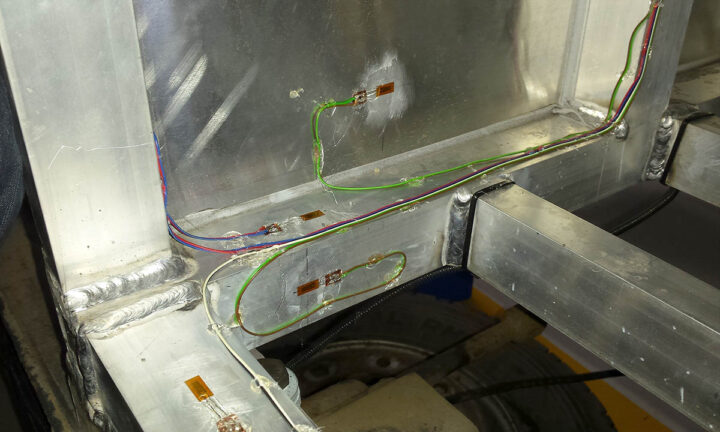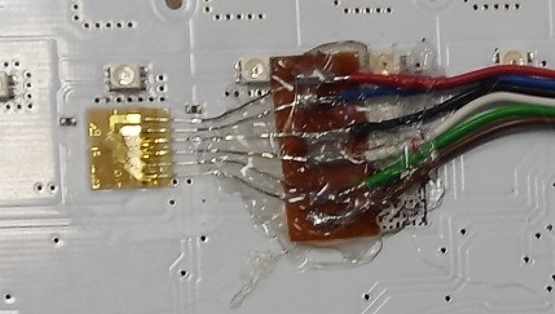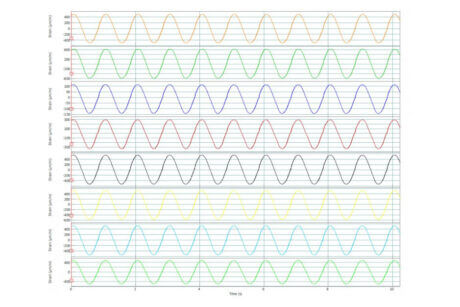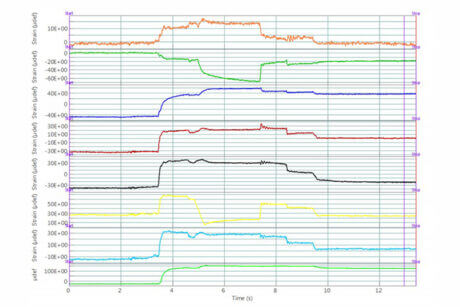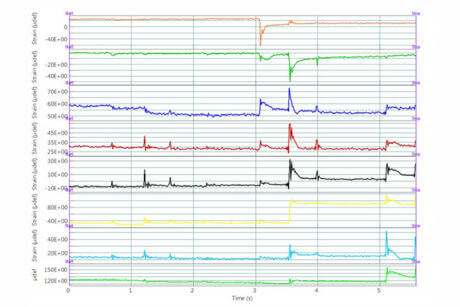Vibration, vibroacoustic (NVH) and tensometric testing

Vibration tests
BOSMAL conducts various types of vibration tests. Elements tested include:
- body elements,
- car lamps,
- coolers,
- batteries,
- other components.
BOSMAL vibration systems: 36 kN, 80 kN and 125 kN – comparison of parameters
Vibration system 36 kN
Parameters of vibration system 36 kN
- force: 35,6 kN
- frequency range: 4 – 3000 Hz
- maximum displacement: 76 mm
- maximum acceleration: 100 g (sinus/random), 260 g (mechanical shocks)
- maximum load up to: 600 kg
- head-expander dimension: 600 x 600 mm
- slip table dimension: 914 x 914 mm
Parameters of Climats climatic chamber
- internal dimension: 1500 x 1500 x 1500 mm (volume 3,4 m3)
- temperature range (working with vibration bench): from -40 to 160ºC; working alone: from -75 to 180ºC (10K/min)
- relative humidity: from 10 to 98 % RH (at temperatures from 10 to 90ºC)
- rate of temperature change: 10ºC/min (with interior heat distribution)
Vibration system 80 kN
Parameters of vibration system 80 kN
- force: 80 kN
- frequency range: 4 – 2000 Hz
- maximum displacement: 76 mm
- maximum acceleration: 100 g (sinus/random), 260 g (mechanical shocks)
- maximum load up to: 1000 kg
- head-expander dimension: 800 x 800 mm
- slip table dimension: 1200 x 1200 mm
Parameters of Climats climatic chamber
- internal dimension: 1500 x 1500 x 1500 mm (volume 3,4 m3)
- temperature range (working with vibration bench): from -40 to 160ºC; working alone: from -75 to 180ºC (10K/min)
- relative humidity: from 10 to 98 % RH (at temperatures from 10 to 90ºC)
- rate of temperature change: 10ºC/min (with interior heat distribution).
Vibration system 125 kN
Parameters of vibration system 125 kN
- force: 125 kN (sinus/random), 360 kN (mechanical shocks)
- frequency range: 4 – 2000 Hz
- maximum displacement: 100 mm
- maximum acceleration: 100 g (sinus/random), 200 g (mechanical shocks)
- maximum load up to: 2000 kg
- head-expander dimension: 1200 x 1200 mm
- slip table dimension: 1500 x 1500 mm
Parameters of Weiss Technik climatic chamber
- internal dimension: 2800 x 2500 x 1400 mm (volume 9,8 m3)
- temprature range: from -45 to 180°C (10K/min)
- relative humidity: from 10 to 98 % RH
- rate of temperature change: 6K/min (3K/min with a loading of 1T)
Resistance to sinusoidal vibration, random and mechanical shock tests
Vibration system working in conjunction with climatic chamber
Vibrations and mechanical shocks are generated by an electrodynamic inductor allowing testing on the vertical or horizontal axes.
The climatic chamber is integrated into the vibration test bench, which permits production of the required temperature/climatic condition during vibration tests.
We provide the appropriate power supply; electric load, media circuits (air, cooling liquids, etc.) depending on the required installation conditions of the object under test.
We have one- or three-axis accelerometers with a wide range of sensitivities (selected depending on required usage); the vibration system has 12 input channels allowing multichannel vibration control to be conducted and measurement of the test component’s response.
We also have great experience in designing and producing vibration brackets.
Norms
We conduct tests (PCA accredited scope) according to the following norms:
- PN-EN 60068-2-6 – Environmental testing. Tests. Test Fc. Vibration (sinusoidal)
- PN-EN 60068-2-27 – Environmental testing. Tests. Test Ea and guidance. Shock
- PN-EN 60068-2-64 – Environmental testing. Tests. Test Fh. Vibration, broadband random and guidance
- VW80000, BMW GS97073-1, Renault 31-07-004, Toyota TSC3000
- and many other manufacturer norms and test programs established with the customer
Testing scope using vibration system
Sinusoidal vibrations (for example, according to PN-EN 600680-2-6) and random (for example, according to PN-EN 60068-2-64)
- frequency range from 4 Hz to 3000 Hz,
- maximum displacement (peak-peak): 76 mm
- maximum acceleration to 1000 m/s2 (100 g),
- maximum mass of object tested to around 600 kg,
- dimensions of the sliding table: 914 x 914 mm
- exposure towards vertical or horizontal axis
Mechanical impacts according to PN-EN 60069-2-27 (for example):
- various shapes of impacts (half sinusoid, trapeze, triangle, etc.),
- maximum acceleration to around 2600 m/s2 (260 g),
- maximum mass of test object around 600 kg,
- exposure towards the vertical or horizontal axis,
- shock realisation 100 g 11 ms (at loads up to 40 kg)
- shock realisation 100 g 6 ms on the sliding table (at loads up to 10 kg)
-
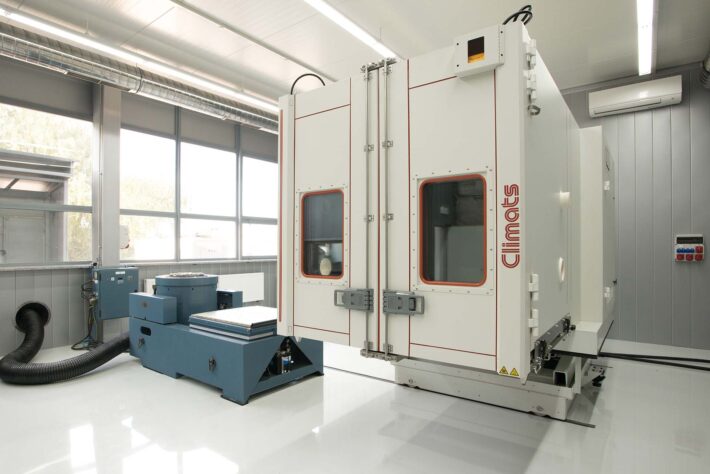
Vibration system – 36 kN -
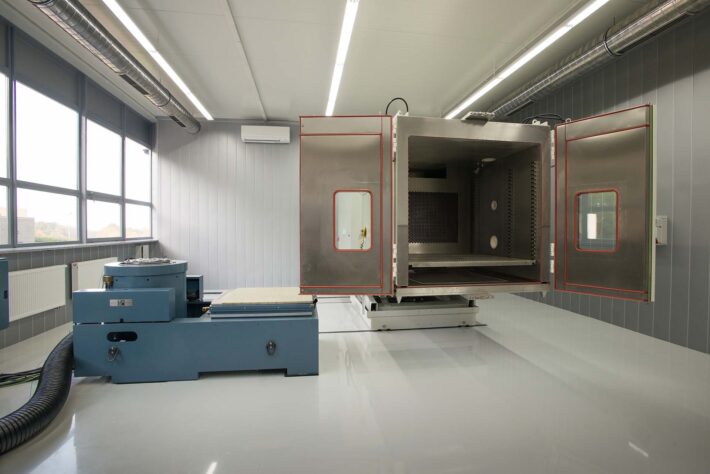
Vibration System – 36 kN with open climate chamber -
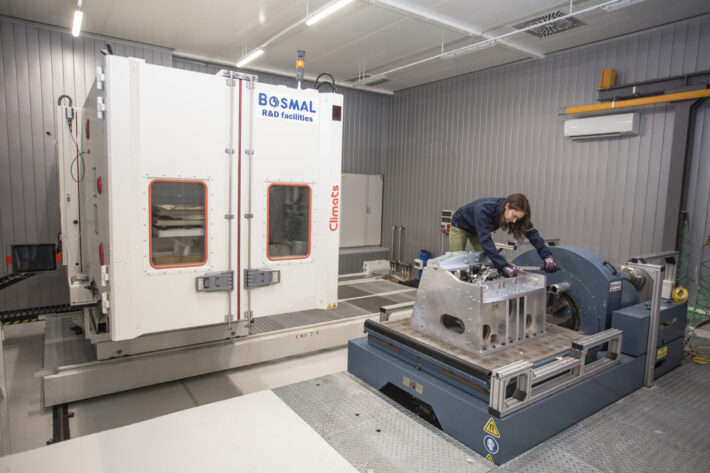
Vibration system – 80 kN – assembly of test object -
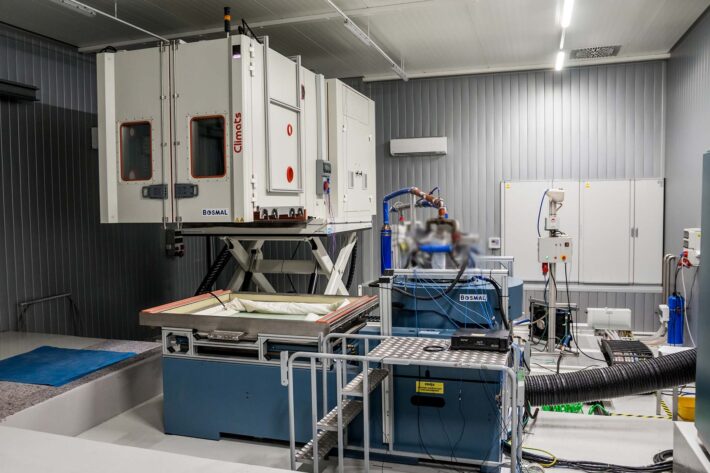
Vibration System – 80 kN – cooler test -
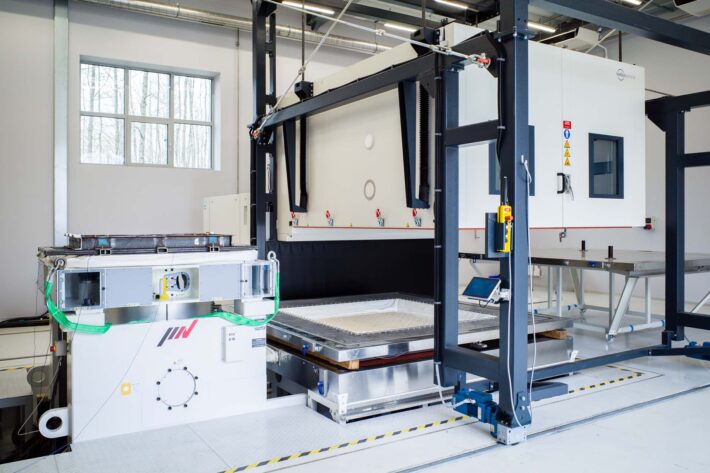
Vibration System 125 kN -
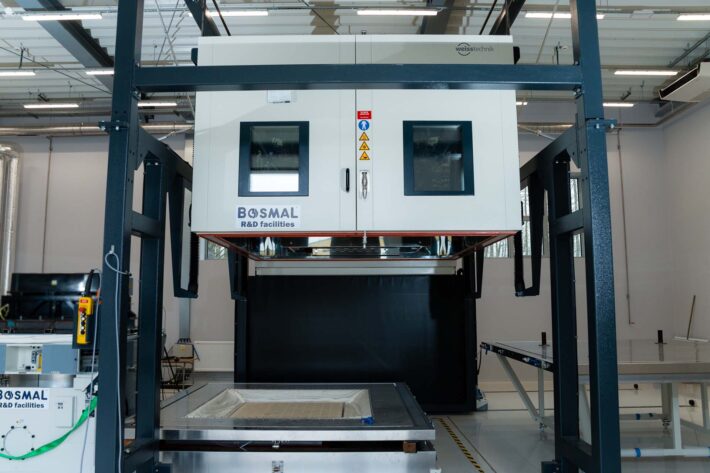
Vibration system 125 kN – climatic chamber -
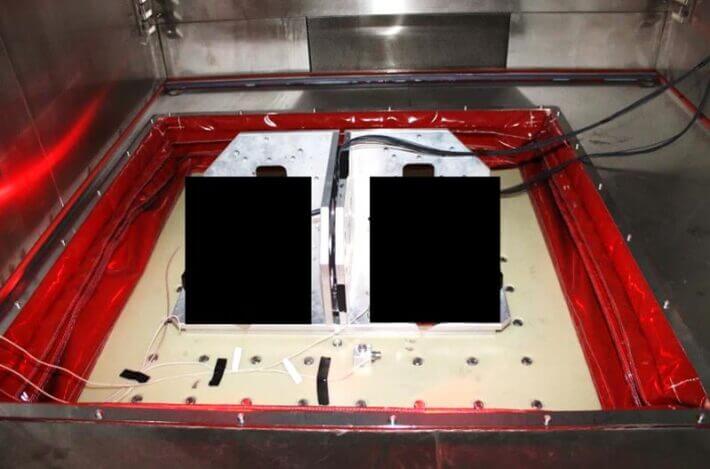
Testing of vehicle lamps on a vibration test rig in a climate chamber -
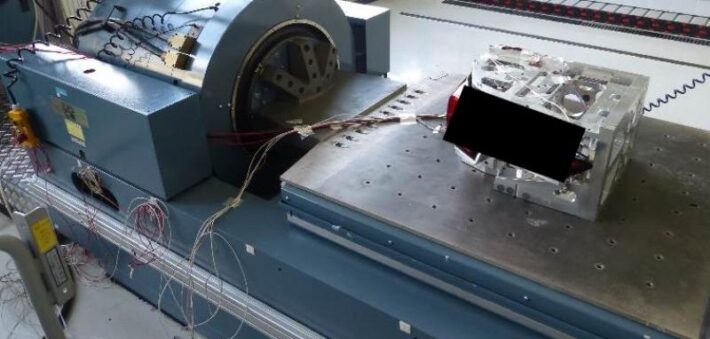
Vehicle lamp testing on a vibrating test bench
Noise and vibration (during road testing)
We perform noise and vibration measurements during road testing, making use of multichannel DAQ devices by firms such as: Brüel&Kjaer, OROS and DEWESOFT.
Analyses
- Frequency (FFT, CPB, FRF and others)
- Time Domain
- Order
- Torsional vibration measurements
- Operational Deflection Shapes (ODS)
- Overall
- Plots as a function of time, rotational speed, frequency, order, etc.
Transducers
- Single- and three-axis vibration sensors (ICP, charge)
- Non-contact displacement sensors (CAPACITEC)
- laser for measurement of torsional vibrations (Bruel&Kjaer)
- force transducers (PCB), modal hammer (Bruel&Kjaer)
- polarised (200 V) class 1 microphone (Bruel&Kjaer and G.R.A.S.)
- sound intensity meter (G.R.A.S.)
Norms
- UNECE Regulation No. 59
- UNECE Regulation No. 51
- UNECE Regulation No. 28
- PN-ISO 362:2003
- PN-ISO 7188:2003
- Fiat 7.R3000, 7.R2100*
*Customer to provide norms for testing
Testing resistance to acoustic vibrations
Norms
- NO-06-A107
- NO-06-A103
Vibroacoustic device measurements
Main aims of vibration measurements
- evaluation of the effect of vibration on durability
- solving fatigue problems
- evaluation of material noise
- establishing critical work points (frequency, speed, etc.) at which the vibrations of highest amplitude occur
- establishing the main reasons behind excessive noise emissions
- evaluation of wear of machinery components – diagnostics
- limiting vibration with the aim of ensuring safety and comfort
Vibroacoustic measurements
- measurements of vibration in gearmotors, window lifters, wiper mechanisms, sunroof mechanisms, etc.
- steering wheel vibration measurements at engine idle
- vehicle door vibration measurements during closing (damping)
- engine and exhaust system vibration measurements
- low frequency vibration measurements using a seismic sensor – for example, in order to evaluate floor vibrations under precise measuring machines
- vibration measurements with non-contact sensors
- vibration measurements with triaxial sensors at temperatures up to 260℃
- analyses: FFT, order, overall, CPB, Time Domain
- acquisition of 32 channels at a frequency of up to 40 kHz
- acoustic pressure level measurements
- spectral analysis of vibration and noise
- establishing the acoustic power of machines and devices in situ
- noise acquisition for subjective evaluations
Norms
- PN-EN ISO 9614-1
- PN-EN ISO 9614-2
- PN-EN ISO 9614-3
- PN-EN ISO 3746
Analyses
- frequency analysis (FFT, CPB, FRF and others)
- time analysis (Time Domain)
- order analysis (Order)
- torsional vibrations measurements
- ODS (Operational Deflection Shapes)
- Overall
- diagrams in time function, rotation speed, frequency, order, etc
Converters
- vibration sensor 1 axial (to 480℃)
- vibration sensors 3 axial (loading up to 260℃ and ICP)
- CAPACITEC non-contact displacement sensors
- IVS-500 Industrial Vibration Sensor (POLYTEC)
- torsional vibration measuring laser (Bruel&Kjaer)
- power converter (PCB) and modal hammer (Bruel&Kjaer)
- polarised (200 V) class 1 microphones (Bruel&Kjaer and G.R.A.S.)
- sound intensity probe (G.R.A.S.)
Equipment
- We have a multi-channel DAQ equipment from companies such as Brüel&Kjaer, OROS, DEWESOFT
Acoustic measurements in an anechoic chamber
Anechoic chamber
This acoustic chamber is built in such a way to minimise the level of acoustic background and acoustic waves reflected from the walls and limit the external noise. Sounds from the outside are strongly suppressed due to the walls’ acoustic insulation and the materials used. Internal surfaces are covered in material with strong sound-absorbing properties; the chamber is lined with “porfles” tiles. Lighting and electricity, together with a table allowing set up of the measuring apparatus are located inside the chamber.
Norms
- Determination of sound power levels and sound energy levels of noise sources using sound pressure – survey method using an enveloping measurement surface over a reflecting plane (PN-EN ISO 3746).
- Determination of sound power levels and sound energy levels of noise sources using sound pressure – engineering methods for an essentially free field over a reflecting plane (PN-EN ISO 3744).
- other industry norms (manufacturers’ own)
Analyses
- Frequency analysis (FFT, CPB, FRF and others)
- Time analysis (time domain)
- Order analysis
- Overall
- Graphs as a function of time, rotational speed, frequency, order, etc.
Converters
- polarised (200 V) class 1 microphones (Bruel&Kjaer and G.R.A.S.)
- class ICP 1 microphones (PCB)
Measuring apparatus
- We use DAQ equipment from companies such as: Brüel&Kjaer, OROS.
Testing the acoustic properties of materials
We provide the following services:
- determination of the sound absorption coefficient in an impedance tube, reverberation room and a small Alpha cabin,
- determination of acoustic insulation (TL) in an impedance tube and joined chambers via the intensity method,
- measurements of other parameters such as acoustic impedance, coefficient of reflection, etc.
- ISO 10534-2
- ASTM E1050
- ISO 11654
- ASTM E2611
- ISO 15186-1
- ISO 354
- ASTM C423
- Fiat 7.R7401
- Fiat 7.R0146
- FCA LP.7R065*
*Customer to provide norms for testing
Strain gauge measurements
Strain gauge measurements
Direct measurements of deformation using strain gauges at temperatures up to 200°C. Measurements in quarter-bridge, semi-bridge and full-bridge systems, with frequency ranges as high as 40 kHz.
Possibility of recording the signal for later analysis.
Static, quasi-static and dynamic measurements.
- PN-EN 60068-2-6 – Environmental testing. Tests. Test Fc. Vibration (sinusoidal)
- PN-EN 60068-2-64 – Environmental testing. Tests. Test Fh. Vibration, broadband random and guidance
- PN-EN 60068-2-27 – Environmental testing. Tests. Test Ea and guidance. Shock
- Fiat 7.R3000 – Fiat 7.R3000
- Fiat 7.R2100 – Fiat 7.R2100
- PN-ISO 7188 – Acoustics – Measurement of noise emitted by passenger cars under conditions representative of urban driving
- PN-ISO 362 – Acoustics – Measurement of noise emitted by accelerating road vehicles – Engineering method
- VW 80000 – Electric and Electronic Components in Motor Vehicles up to 3.5 t. General Requirements, Test Conditions, and Tests
- Regulation No 59 UN/ECE – Regulation No 59 of the Economic Commission for Europe of the United Nations (UN/ECE) — Uniform provisions concerning the approval of replacement silencing systems
- NO-06-A107 – Armaments and military equipment – General technical requirements, inspection and test methods – Methods of testing total resistance to environmental factors
- NO-06-A103 – Armaments and military equipment – General technical requirements, inspection and test methods – Environmental requirements
- PN-EN ISO 3746 – Acoustics – Determination of sound power levels and sound energy levels of noise sources using sound pressure – Survey method using an enveloping measurement surface over a reflecting plane
- PN-EN ISO 9614-1 – Acoustics – Determination of sound power levels of noise sources using sound intensity – Part 1: Measurement at discrete points
- PN-EN ISO 9614-2 – Acoustics – Determination of sound power levels of noise sources using sound intensity – Part 2: Measurement by scanning
- PN-EN ISO 9614-3 – Acoustics – Determination of sound power levels of noise sources using sound intensity – Part 3: Precision method for measurements by scanning
- PN-EN ISO 3744 – Acoustics – Determination of sound power levels and sound energy levels of noise sources using sound pressure – Engineering methods for an essentially free field over a reflecting plane
- FCA LP.7R065 – FCA LP.7R065
- Fiat 7.R0146 – Fiat 7.R0146
- Fiat 7.R7401 – Fiat 7.R7401
- ASTM C423 – Standard Test Method for Sound Absorption and Sound Absorption Coefficients by the Reverberation Room Method
- ISO 354 – Acoustics – Measurement of sound absorption in a reverberation room
- ISO 15186-1 – Acoustics – Measurement of sound insulation in buildings and of building elements using sound intensity – Part 1: Laboratory measurements
- ASTM E2611 – Standard Test Method for Measurement of Normal Incidence Sound Transmission of Acoustical Materials Based on the Transfer Matrix Method
- ISO 11654 – Acoustics – Sound absorbers for use in buildings – Rating of sound absorption
- ASTM E1050 – Standard Test Method for Impedance and Absorption of Acoustical Materials Using a Tube, Two Microphones and a Digital Frequency Analysis System
- ISO 10534-2 – Acoustics – Determination of sound absorption coefficient and impedance in impedance tubes – Part 2: Transfer-function method
Back
to top

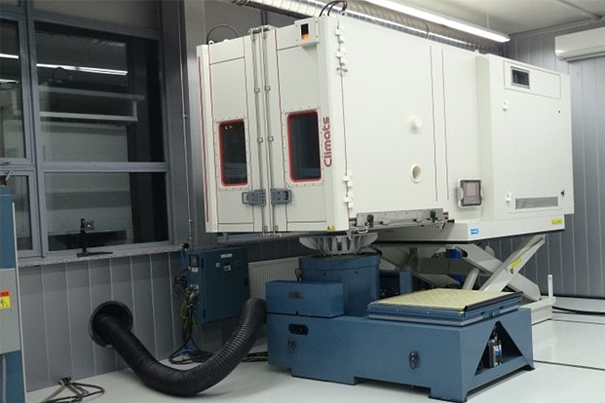
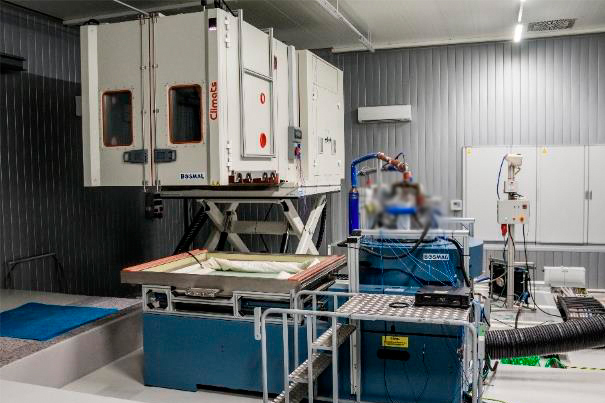
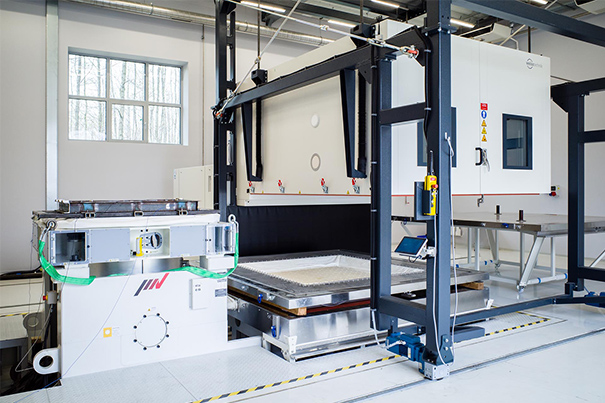
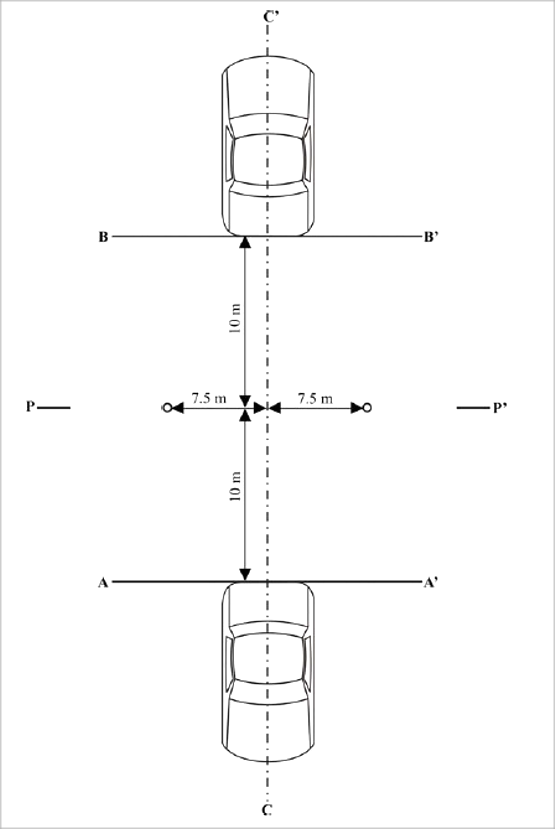
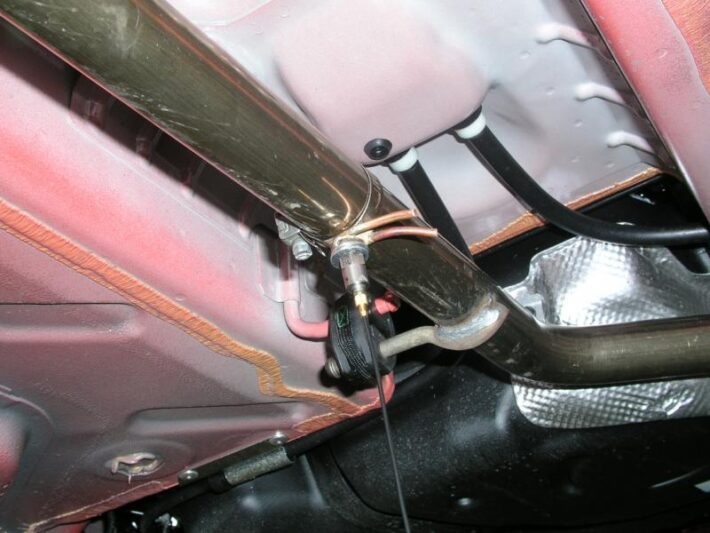
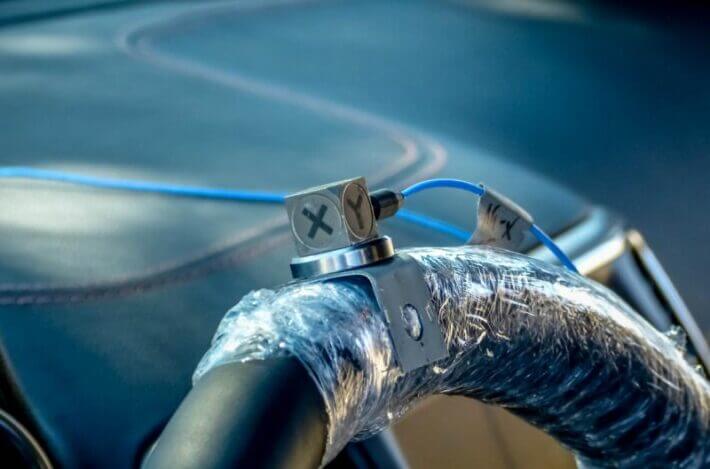
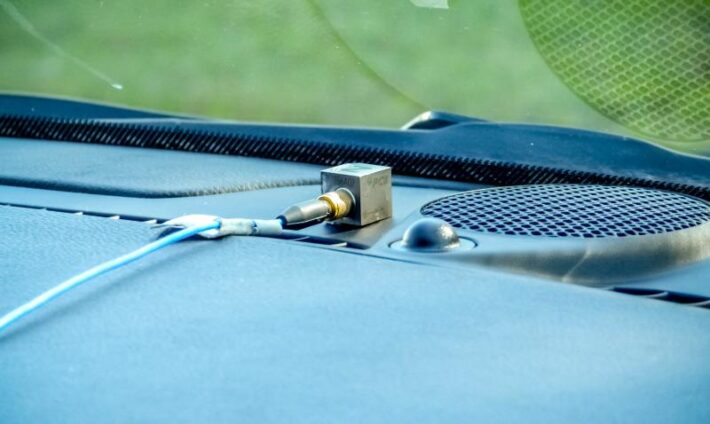
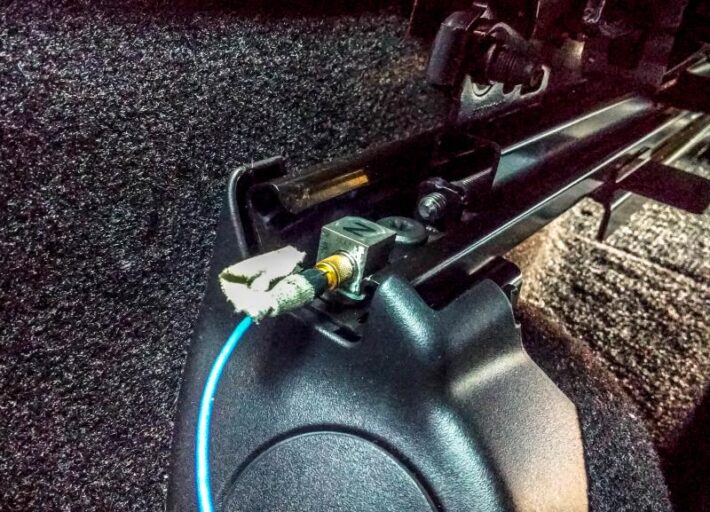
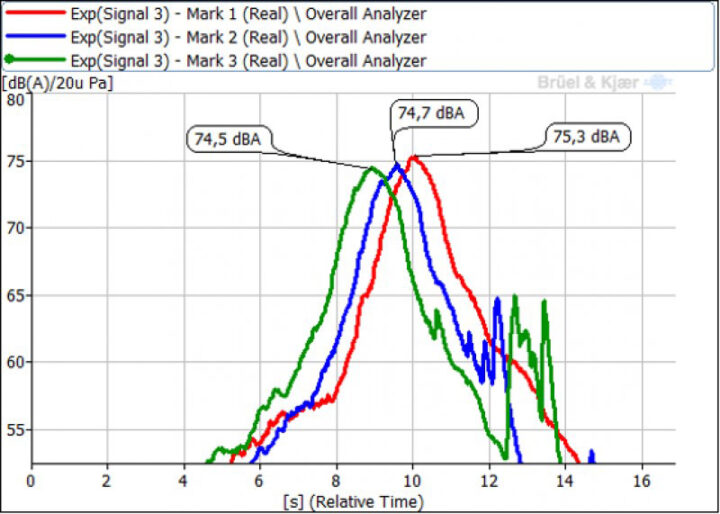
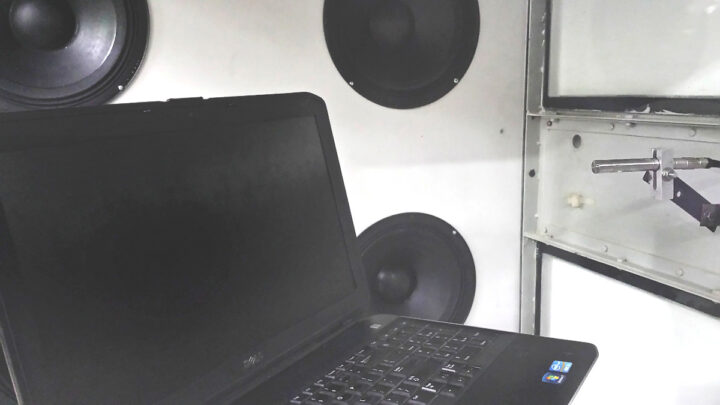
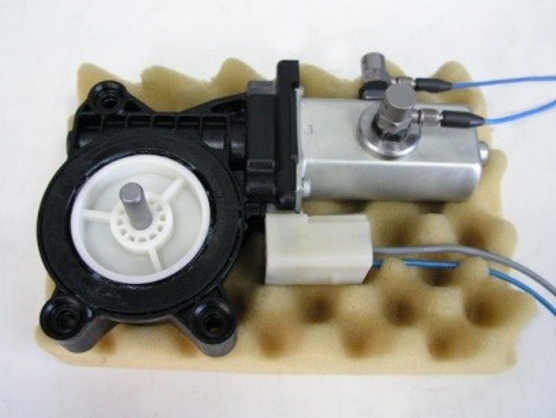
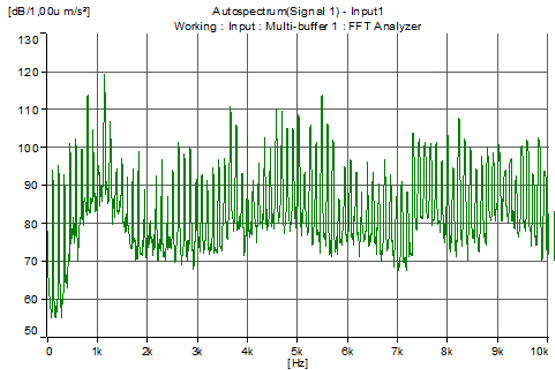
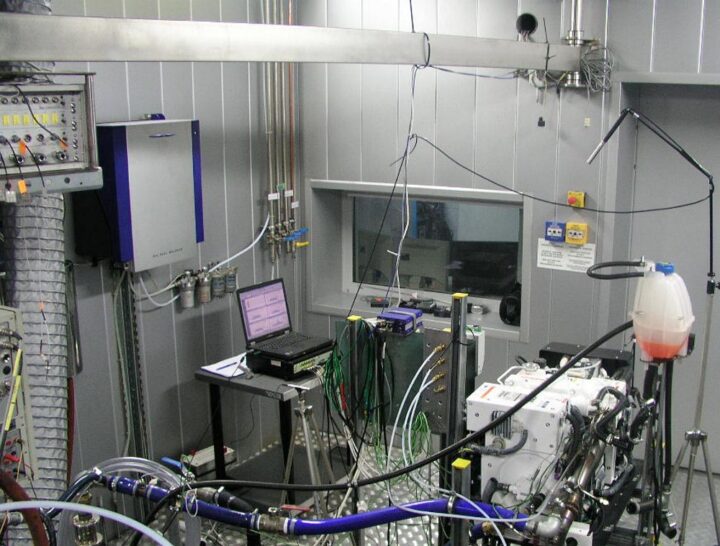
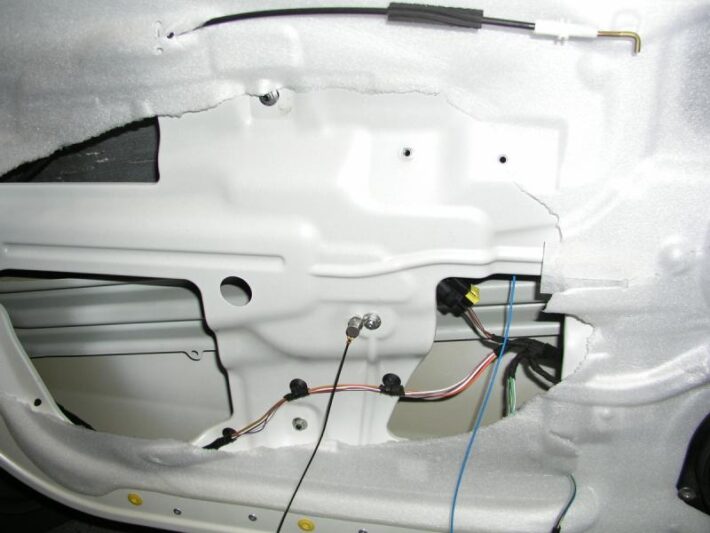
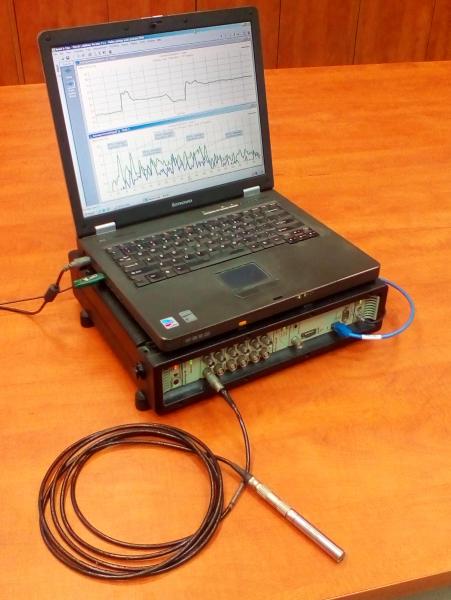
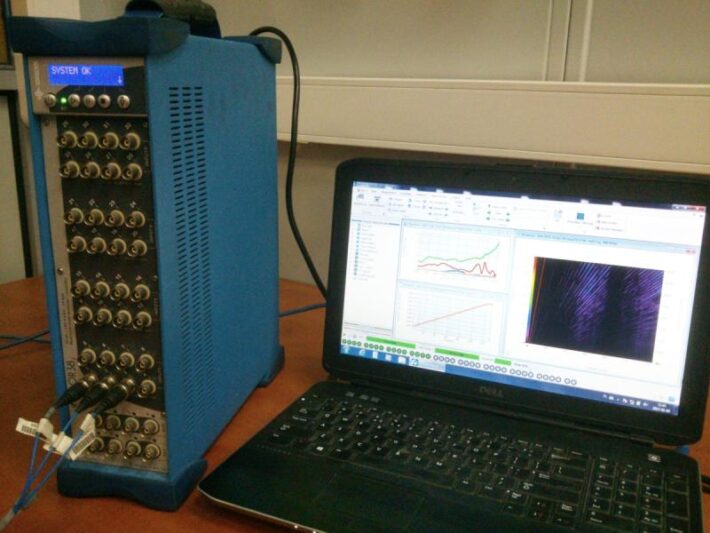
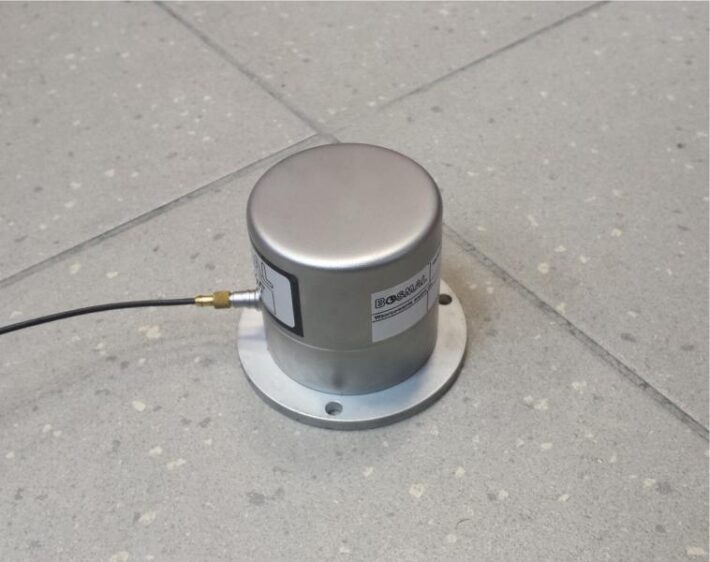
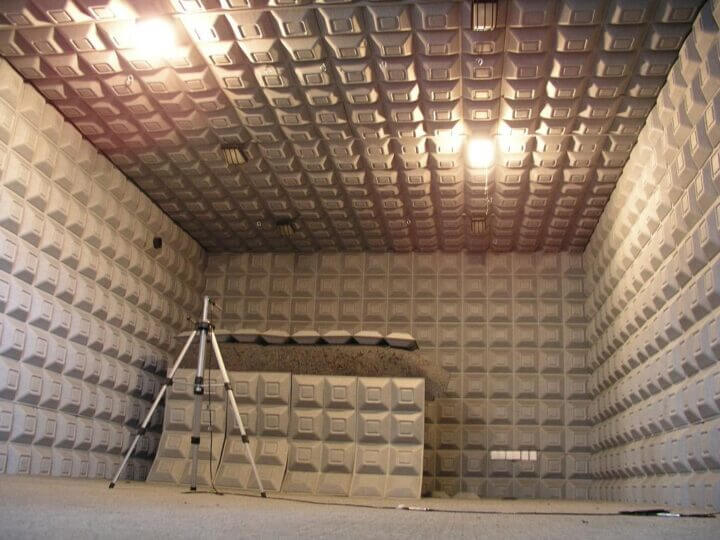
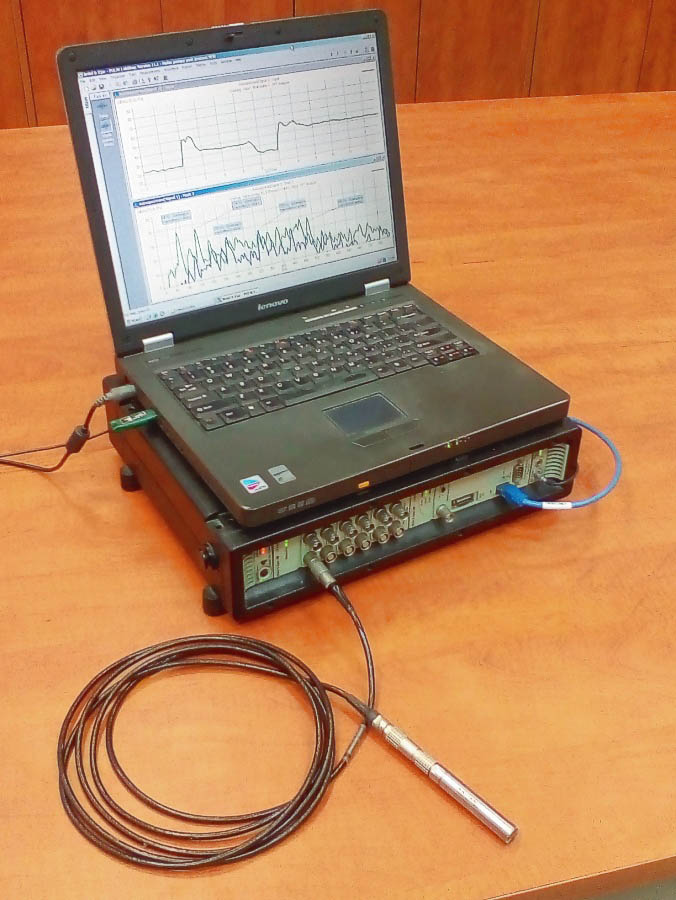
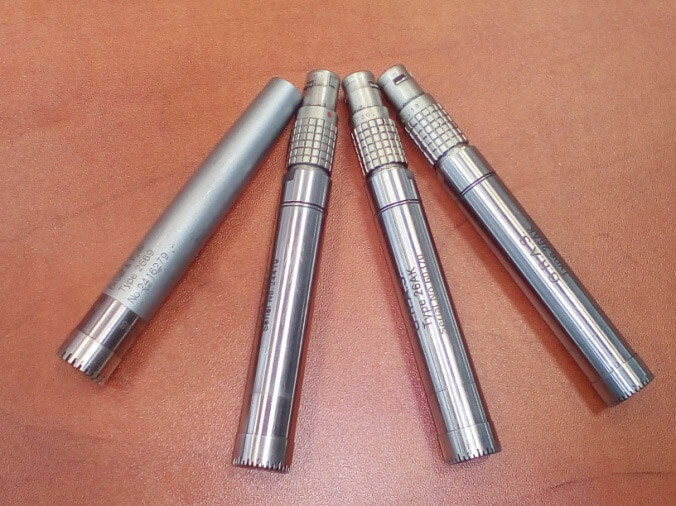
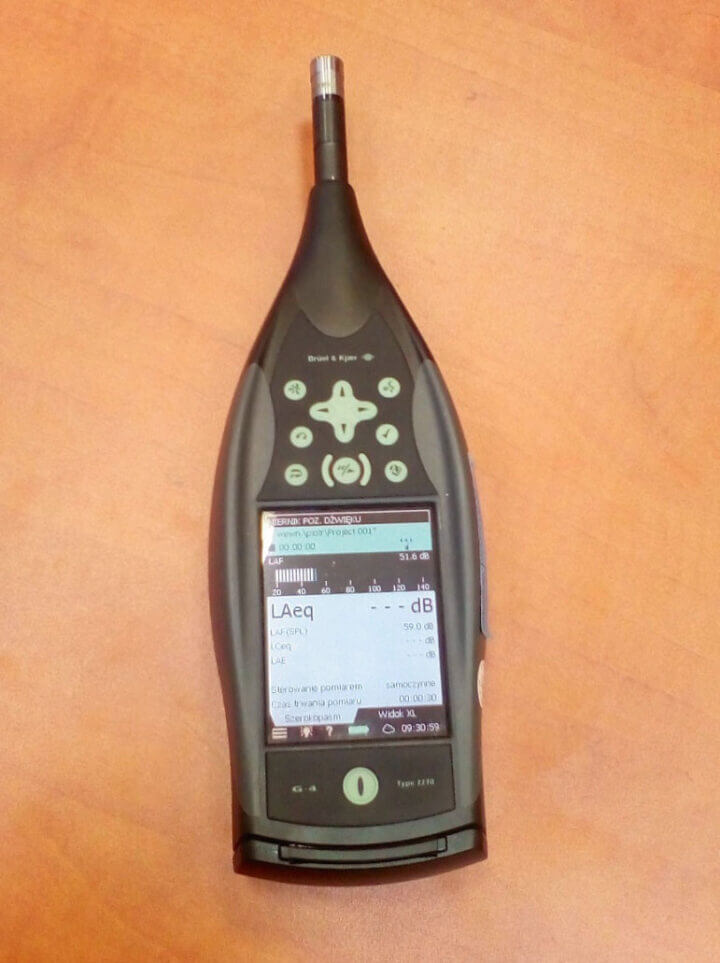
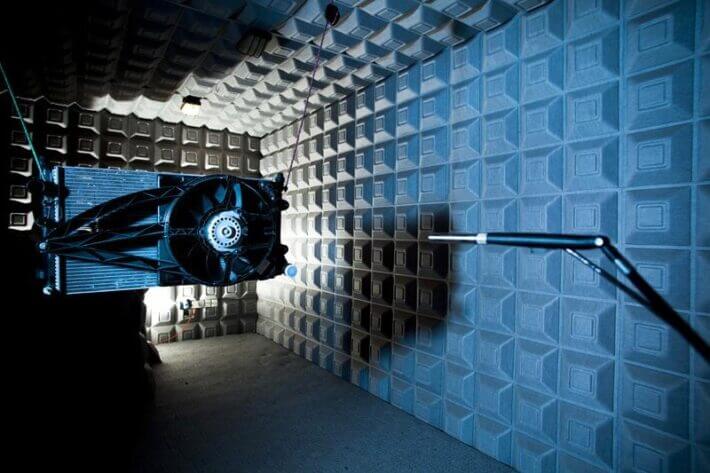
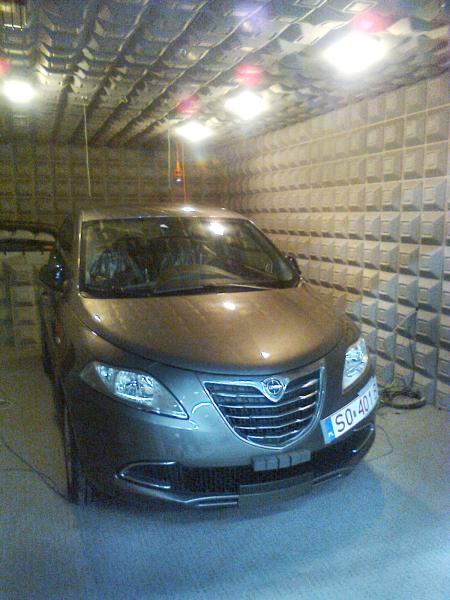
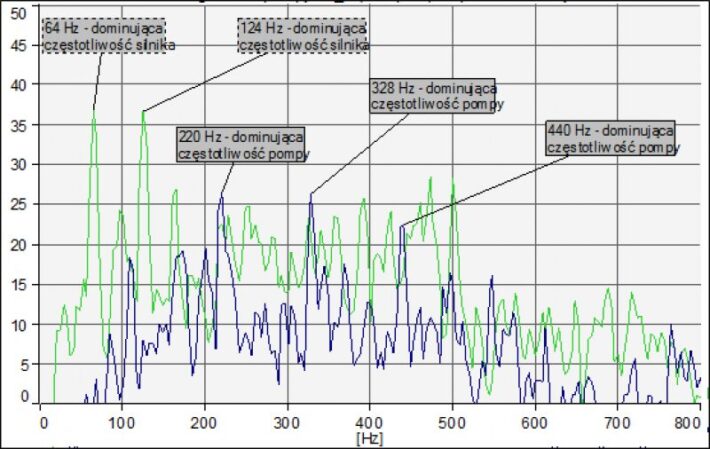
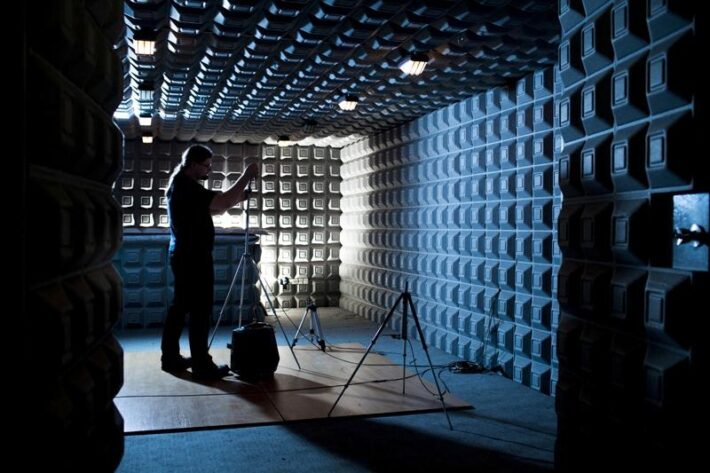
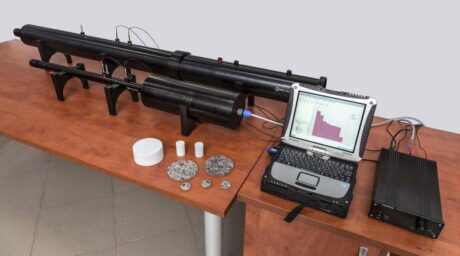
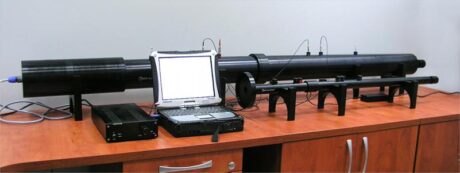
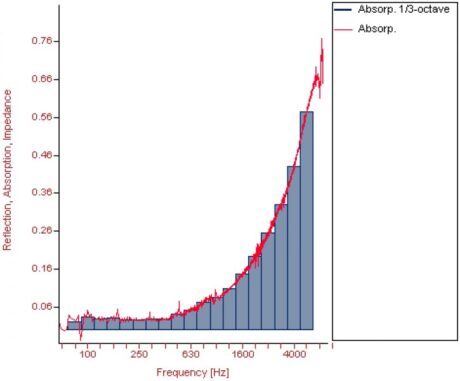
![Transmission Loss [dB]- tertian bands and continuous spectrum](https://www.bosmal.eu/wp-content/uploads/2024/04/Transmission-Loss-dB-pasma-tercjowe-i-widmo-ciagle-460x382.jpg)
